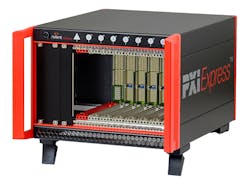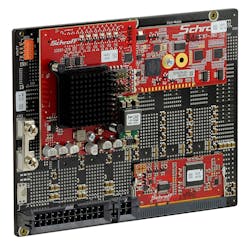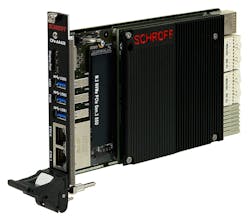This article appeared in Evaluation Engineering and has been published here with permission.
The enabling technologies 5G and edge computing are necessary for the development and introduction of autonomous and driver-less transportation, which also affects the test, measurement and simulation systems used. Different requirements concerning system architecture, environmental conditions, and mechanics must be taken into account. The highest levels of safety and reliability are of great importance for autonomous driving applications. Large data volumes must be captured quickly, transmitted, and processed. This has caused the relevant measurement and test systems to evolve into highly complex IT systems.
Achieving sufficient bandwidth for storing and processing all this sensor data poses a major challenge, as does the necessary data transfer rate to move the overall data volume. This affects both vehicle development and simulation as well as actual driving. Sophisticated onboard infotainment systems, wireless communications via LTE and Wi-Fi, and safety systems such as vehicle radar and target simulations present new challenges for related test and measurement systems.
Gathering and Evaluating Sensor Data
Before test vehicles are sent for trial runs on the road, extensive simulations are carried out to ensure the safety and reliability of the software. This enables errors to be detected and remedied at an early stage. The time spent on development is also reduced since no prototype is released into road traffic until it is safe.
During the test drives, all sensor data is recorded and stored so that it can be subsequently loaded into the simulations. Any remaining software errors can then be easily identified and corrected. These corrections are checked in the simulations that follow to ensure that the desired responses are obtained. Such storage systems must be installed in rugged yet compact enclosures that are housed in special holding frames in the test vehicle, ensuring that they are roadworthy but also easy to exchange.
In the next step, prototypes are tested on the road under realistic conditions. The vehicle's test systems capture all sensor data simultaneously. The concept here is ‘sensor fusion.’ During autonomous driving, signals from multiple sensors such as radar, camera, LiDAR, video, and laser sensors must be captured, linked, and made available to the vehicle concurrently and in real time. The test systems required for this are fitted into the vehicle and should therefore be as small as possible, yet be capable of processing all the sensor data. To achieve a space-saving and compact system solution, a small but powerful system controller is also required.
Autonomous driving not only places increased demands on the simulation, testing, and measurement tasks defined here but also affects the enclosure and cabinet solutions of the testing systems. This relates to the system architecture on the one hand with factors such as high processing power, rapid data transmission and precise synchronization of the components (clock and trigger functions). On the other is the mechanical properties of the test systems. Developers must pay attention to characteristics such as improved EMC shielding, high levels of signal integrity, improved cooling, and appropriate configurations and platform-based developments to ensure the modularity of the test and measurement systems.
Autonomous driving simulations test for function and test products associated with production. PXI Express systems (Fig. 1) are particularly suitable, offering high data output and precise clock and trigger signals for synchronizing these functions. Devices constructed in this way can be easily integrated into IIoT networks and offer sufficient data bandwidth to connect and synchronize the test devices with the rest of the production line. Additionally, detailed data for quality management and documentation is transferred.
System Architecture for Growing Demands
PXI Express is an update of the open PXI platform and offers the widely adopted serial PCI Express bus. PXI Express is based on the 19-inch form factor and offers backward compatibility to PXI, thereby giving access to a large number of dedicated measurement and test boards. With PCIe Gen3 and up to x16 links, PXI Express supports a system bandwidth of up to 24 GB/s for acquiring and evaluating simulated and measured data.
In addition to the increased system bandwidth, PXI Express offers more performance per slot plus extended timing and greater trigger functionality thanks to a dedicated, synchronized 100-MHz differential clock. This supports the synchronization of measurement data. For measurement systems with more than four slots, the PCI Express bus is extended by one or more PCI Express switches. To support the older PXI boards on the parallel 32-bit PCI bus in the chassis as well as the PXI Express boards, a PCIe-to-PCI bridge is required. Compact PCI and PXI boards and Compact PCI Express can also be integrated into the system using appropriate hybrid slots.
In general, a PXI Express system is divided into two parts. One part includes the plug-in boards (processor boards, measurement boards, IO boards, etc.) that are combined specifically to the application, to create the intended function of the system. The other part, the PXI Express chassis, provides the necessary infrastructure for the operation of the plug-in boards, including the physical enclosure, backplane, cooling and power supply (Fig. 2).
Today’s test equipment manufacturers expect a high level of flexibility with respect to the design and the technical characteristics of their products. Therefore, enclosure solutions such as the PXI Express chassis from nVent Schroff, which has a modular construction based on the RatiopacPRO enclosure platform and requires only minor modifications for a wide range of applications. are particularly suitable. If the PXIe system is to be installed in an electronics cabinet, the same electronics can be housed in a modular subrack mechanism. Suitable product platforms offered here by nVent Schroff include EuropacPRO.
Backplane: Passive and Modular
The PXIe standard is based on many active functions such as switches, bridges and clock switching, and timing signal generation being provided within the enclosure. In many of the systems currently on the market, these active components are integrated directly onto the backplane. One consequence of this is that changes or modifications can be very complex.
nVent has solved this problem another way. To ensure that the backplane can be quickly adapted, it is designed to be as passive as possible, and the PCI bridge, PCIe switch, and clock functions are implemented as separate modules and placed to the rear of the backplane, between or above the slots (Fig. 3). Compared to backplanes in which these functions are fully integrated, the result is a more compact construction. The modular concept enables standard components to be used, and any PXI Express backplane configuration can be easily implemented. The decoupling of the active switching elements on the modules also reduces EMC emissions. Further, development time for the backplane is reduced, since its function is limited to signal routing.
Power-Supply Systems for Industrial Use
Wherever possible, the power-supply units to be used must be available throughout the entire expected product life cycle in order to avoid costly recertification of the systems. nVent Schroff therefore uses suitable industrial-grade PSUs that provide the conventional PC voltages (3.3 V, 5 V, ±12 V, and 5 V standby). To ensure that the boards inserted into the system are correctly initialized and that all functions are recognized by the system controller during the boot process, the proper switch-on and switch-off behavior of the different voltages is also important. A separate controller in the system monitors and controls the voltages, thereby preventing any possible data loss or potential damage to a plug-in board caused by an uncontrolled switch-off of the supply.
The controller also performs additional functions in the PXI Express system. For example, it supplies the system status to the system controller, the CPU board, via an I2C interface. This ensures, among other things, that the temperature-controlled fans provide the correct balance between cooling capacity and fan noise under all system conditions. If the system controller is also modular in construction (e.g. consisting of a COM module plus carrier) the processor can be easily replaced and the processing power thus matched to the application (Fig. 4). It is even possible to move to the next processor generation without the need for a redesign.
Since PXI Express systems can be used in many different applications, there are also different requirements regarding modularity, load capacity, and EMC properties. Modular platforms such as the EuropacPRO subrack and the RatiopacPRO enclosure satisfy these requirements in mechanical terms and further offer the possibility of customized branding or an individual aesthetic, even in small batch sizes. Each PXI Express chassis can thus be implemented individually, quickly, and with low risk. This is regardless of whether it will be used as a tabletop unit in a laboratory or as a subrack in an electronics cabinet in which multiple systems are combined.
For customized tasks, it is generally recommended to work with a specialist from the beginning to ensure that sufficient support is available from the initial phase. Particularly when defining a system architecture suitable for the desired application, it is often necessary to obtain extensive support and advice from specialists. This ensures that all essential parameters are taken into account from the beginning, which in turn keeps the development time as short as possible.
Summary
Autonomous driving and the networking of vehicles require fast data networks and real-time processing of large volumes of sensor and traffic data. To ensure the highest level of safety, extensive testing and simulation are necessary. The system architecture of the enclosure and cabinet solutions must also be capable of meeting these high demands. PXI Express systems offer a good platform here.
Christian Genninger is Global Product Manager, Embedded Systems, at nVent Schroff.




